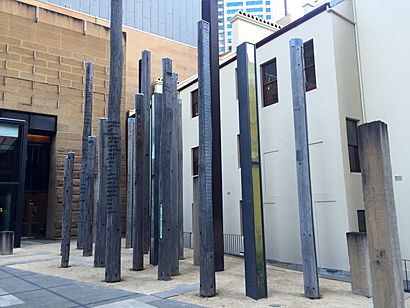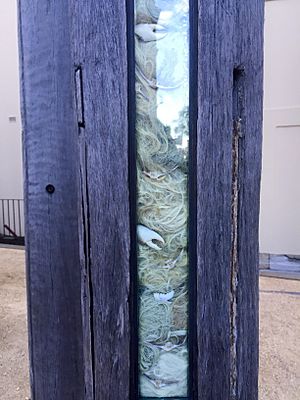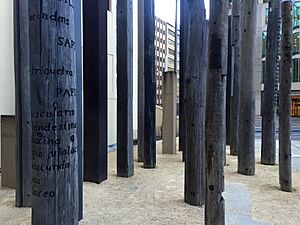Edge of the Trees facts for kids
Quick facts for kids Edge of the Trees |
|
|---|---|

View of artwork when entering the forecourt of Museum of Sydney
|
|
| Artist | Janet Laurence (in collaboration with Fiona Foley) |
| Year | 1995 |
| Type | Sculpture |
| Medium | Sydney sandstone, wood, steel, oxides, shells, honey, bones, zinc, glass, sound |
| Location | Museum of Sydney, Sydney, Australia |
| 33°51′49″S 151°12′41″E / 33.86363°S 151.21131°E | |
| Owner | Museum of Sydney |
Edge of the Trees is a special artwork made by two artists, Janet Laurence and Fiona Foley. It's a type of art called site-specific, which means it was created especially for the place where it stands. You can find it at the front of the Museum of Sydney in Sydney, Australia. It has been there since the museum opened in 1995. The artwork is made of 29 tall pillars using materials like wood, steel, and sandstone. It also includes sounds, making it a unique experience. This public artwork has won awards because it tells important stories about the history of the land and the people who lived there.
Contents
What is "Edge of the Trees" About?
The main idea behind Edge of the Trees is to help us understand the past. It looks at the history of the land, the Indigenous people, and those who arrived later. The name of the sculpture comes from an essay by a historian named Rhys Maengwyn Jones. He wrote about how early explorers arriving by sea saw people "looking at them from the edge of the trees."
This means that the same landscape, which seemed strange to the newcomers, was a familiar home to the Indigenous people. Edge of the Trees shows the meeting and interaction between Aboriginal and non-Aboriginal people at this important site. This place was where the first contact happened between them.
The artists wanted to share many layers of memories about this place. They used different materials, names, and maps to do this. These memories include the history of plants, the history of the Eora people (the Aboriginal group from Sydney), and the history of the Colonial period (when Europeans settled).
This artwork is "site-specific" because it directly relates to the Museum of Sydney. The museum's idea was to explore the history of the area. Janet Laurence was one of the artists asked to create a design for the museum. She invited Fiona Foley, an Aboriginal artist, to work with her. Fiona Foley brought important cultural knowledge and helped choose materials that only an Aboriginal artist would know to use.
Materials and Messages

Edge of the Trees looks like a "forest" of 29 large pillars. These pillars are made from wood, steel, and sandstone. They stand together at the museum's entrance. The wooden pillars remind us of the trees that once grew on this land. The wood comes from Ironbark and Tallow wood trees found around Sydney.
The sandstone pillars represent Sydney's historic buildings and the natural rock the city is built on. Steel is used to connect the artwork to the modern steel and glass parts of the museum building. It also reminds us of the industrial growth that happened after the colonial period.
Inside the wooden pillars, you can see Organic materials like human hair, shells, bones, feathers, ash, and honey. These items are placed in small windows. They are there to remember and honor the lives of the people who lived around this site long ago.
The pillars also tell stories through words. Names of plants are carved or burned into the wooden columns in both Latin and Aboriginal languages. You can also find the names of the First Fleeters, who were the first Europeans to arrive in Sydney in 1788. Place names are also carved onto the sandstone pillars in both Latin and Aboriginal languages.
The 29 tall poles represent the 29 Aboriginal clans (family groups) from the Sydney area. This artwork is meant to be experienced up close, not just viewed from far away. Visitors are invited to touch the pillars and feel the different textures and engraved names. As you walk among the pillars, you can hear sounds of Koori (Aboriginal) voices. They recite the names of places in the Sydney region that are now part of the big city. This helps to celebrate and remember those places and their history.
Awards and Recognition
- 1995: Lloyd Rees Award for Outstanding Urban Design, Australian Institute of Architects.
Gallery
See also
- Veil of Trees








